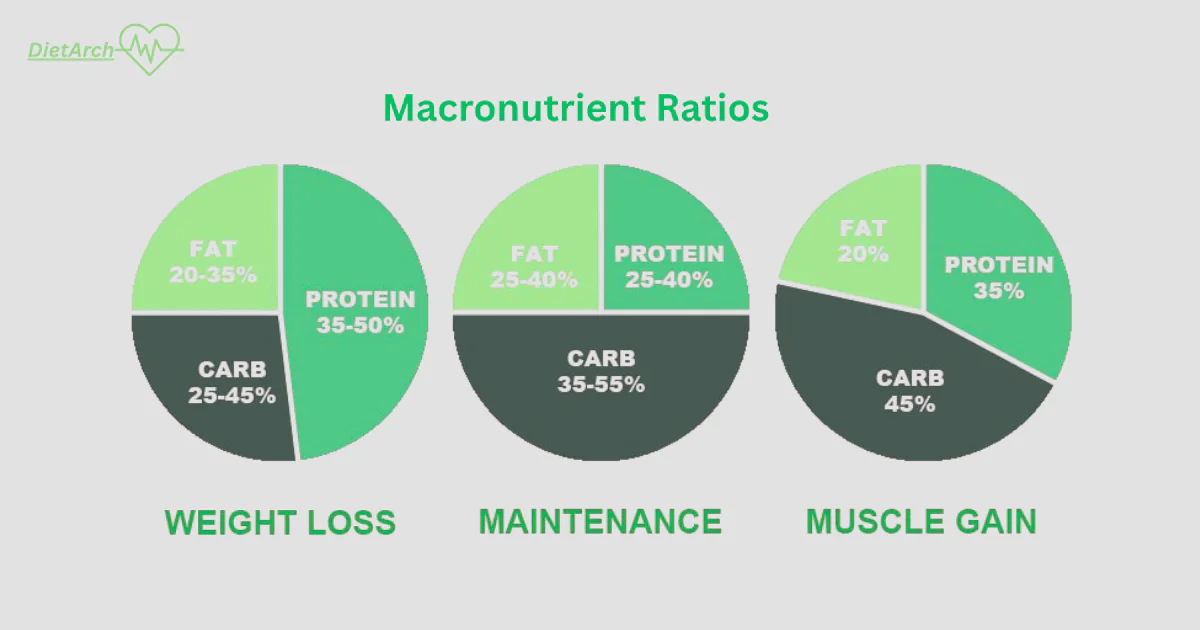Ultimate Guide to Using a Macronutrient Calculator (Updated 2025)
Use our macronutrient calculator. Whether you are just starting your health journey or you are a professional athlete, do these simple steps and achieve your major macro targets.
Macro Calculator
Macronutrient Calculator
Get your personalized daily macro targets for any goal.
Your Personalized Results
Your BMR: 0 kcal
Maintenance (TDEE): 0 kcal
Carbohydrates
0g
(0 kcal)
Protein
0g
(0 kcal)
Fat
0g
(0 kcal)
Optional Meal Breakdown
| Meal | Carbs (g) | Protein (g) | Fat (g) |
|---|
Understanding Your Macros
About Protein
Essential for building and repairing tissues like muscle. Active individuals often need 1.6-2.2g per kg of bodyweight. Good sources include chicken, fish, eggs, lentils, and tofu.
About Carbohydrates
Your body’s primary fuel source, especially for your brain and intense exercise. Focus on complex carbs from vegetables, whole grains, and fruits for sustained energy and fiber.
About Fats
Crucial for hormone production and absorbing vitamins. Prioritize unsaturated fats from avocados, nuts, seeds, and olive oil. Limit saturated and trans fats.
How to Use Our Macronutrient Calculator
- Put age, sex, weight, height, activity level, and goal
- The calculator displays daily macro targets in grams
- Log meals manually or via barcode scanner
- Review macro breakdown and progress analytics
What Are Macronutrients (“Macros”)?
Macronutrients are the nutrients our body needs in large amounts to perform daily activities. The three macronutrients are proteins, carbohydrates, and fats. These are often listed on food labels under “macros.” While some definitions also include water, minerals (like calcium and sodium), and even oxygen, this guide focuses on the big three that supply energy and support growth and repair.

In contrast, micronutrients are required by our body in trivial amounts. They include vitamins and minerals. The human body requires less than 100 milligrams of micronutrients each day.
Proteins
Proteins are made up of chains of amino acids, which are the building blocks for muscles, organs, enzymes, and many other tissues. The amino acids that cannot be synthesized by the body and must come from food are called essential amino acids.
Health Tip: Choose lean, minimally processed proteins, and avoid foods like fried meats, processed items, and high-sugar yogurts.
Carbohydrates (“Carbs”)
Carbs are our body’s preferred quick energy and major source. There are two main forms:
- Simple carbs: Sugars like glucose and fructose, found in fruits, sweets, and processed foods
- Complex carbs: Starches and fibers in vegetables, whole grains, legumes, and some fruits
Health Tip: Focus on fiber-rich whole foods like vegetables, fruits, whole grains, and minimize added sugars found in sodas, candies, and many packaged snacks.
Fats
Dietary fats are molecules made mostly of carbon and hydrogen. Despite their reputation, fats are vital for many body processes:
Fats are classified by their chemical bonds:
Health Tip: Replace saturated and trans fats with monounsaturated and polyunsaturated fats whenever possible, and keep total fat intake moderate.
Do not forget to check your BMI.
How to calculate Daily Calorie needs?
The number of calories required by the human body daily is called the daily calorie need. It depends on factors like age, weight, height, gender, physical activity, and the goal to lose, maintain, or gain weight. Mostly nutritionists and online calculators often start by estimating your Basal Metabolic Rate (BMR) or resting daily energy expenditure, which is the calories you burn at rest. They use formulas like Mifflin‑St. Jeor or Katch‑McArdle. The Katch-McArdle formula is used when taking lean body mass. They then multiply by an activity factor to get your total daily energy needs.
Recommended ranges:
Once you have set your calorie goal, you can divide those calories into macros:
For example, if your goal is 2,000 calories:
The results given by the calculator are based on guidelines provided by a number of authorized institutions, such as the American Dietetic Association, Centers for Disease Control and Prevention, World Health Organization, and more.
Do not forget to check your IBW.
What is a Macronutrient Calculator
A macronutrient calculator like ours estimates how many grams of protein, carbs, and fats you need daily. Use it to align your diet with personal goals like weight loss, muscle gain, or maintenance. It turns calorie targets into actionable meal plans tailored to your body needs and activity level.
Common activity multipliers:
How our calculator estimates Your Energy Needs
- Calculate Basal Metabolic Rate (BMR) using the Mifflin. St Jeor formula
- Apply the activity multiplier based on lifestyle
- Adjust calories with surplus for muscle gain or deficit for weight loss
- Convert total calories into macro grams using your ratio strategy
Mifflin-St–Jeor is the most accurate predictive formula, matching indirect calorimetry within ±10% for most non-obese and obese adults.
BMR Formulas (Metric)
The Macronutrient Ratio of splitting
Common macro splits:
For muscle gain: aim for 1 g of protein per pound of body weight and fats at 0.3–0.4 g per pound
Carbs fill the remaining calories after protein and fat are accounted for.
How to calculate the Macro ratio
You must have your Total Daily Energy Expenditure (TDEE) calculated and a clear objective of fat reduction, muscle gain, or weight maintenance for breaking macronutrients.
Instead of using a rigid percentage split, this calculator adapts to individual needs:
Protein Ratio
Protein requirements are calculated on a per‑weight basis. Select the level that corresponds to your activity and body physique:
Adjust downward if your medical considerations (kidney problem) force reduced protein intake.
Fat Ratio
Give 30 percent of daily calories to fats. Dietary fats support the synthesis of hormones, cellular integrity, and nutrient absorption.
Carbohydrate Ratio
Once you have calculated fats and proteins, dedicate the remaining calories to carbohydrates. These macronutrients furnish the primary energy substrate for both high‑intensity exercise and cerebral function.
Customizing Macros with Fitness Goals

Macros for Fat Loss:
If you want to lose fat, adopt a caloric deficit below your TDEE, selecting from mild, moderate, or aggressive reductions. Maintain the macro proportions on a reduced caloric base to preserve lean mass during weight loss.
Adopt this one habit to lose belly fat.
Macros for Muscle Gain:
Implement a 20 percent caloric surplus above TDEE, retain the macro split, and engage in a structured resistance‑training regimen. This approach promotes efficient lean–mass accrual.
Macros for Body Recomposition
Use a specialized recomposition calculator, which balances a slight caloric deficit or maintenance level with increased protein intake to help current fat loss and muscle gain.
Macros for Weight Maintenance:
Make sure your caloric intake matches TDEE precisely. This ratio sustains current weight and composition once goals have been achieved
Advanced Considerations
Lean‑Mass Adjustment:
For enhanced precision, particularly in very lean or obese individuals, it is good to take lean‑mass formulas using body fat percentage. Since muscle tissue expends more energy at rest than adipose tissue, this method refines macronutrient targets.
Meal Distribution:
Divide daily macros into two to six meals according to personal preference. The choice between fewer large meals or multiple smaller ones depends on individual lifestyle and tracking comfort.
Activity Level Impact:
Apply an activity multiplier to TDEE to reflect energy expenditure:
Eat these fruits weekly to lose weight.
What are Common Mistakes & How to Avoid Them
Avoid errors by:
Always measure or weigh food instead of estimating volumes.
Tracking & Adjusting Over Time
Use logs or spreadsheets to track calories and macro trends.
See what other health tools you can use easily.
Benefits of our calculator:
Our calculator gives you the following things in a few clicks
In a nutshell:
Macros do not need to be complicated. Using a reliable calculator based on the Mifflin–St. The Jeor equation, when adjusted according to your goal, provides control and clarity. Recalculate regularly and adjust as needed to accommodate your body’s changes.





